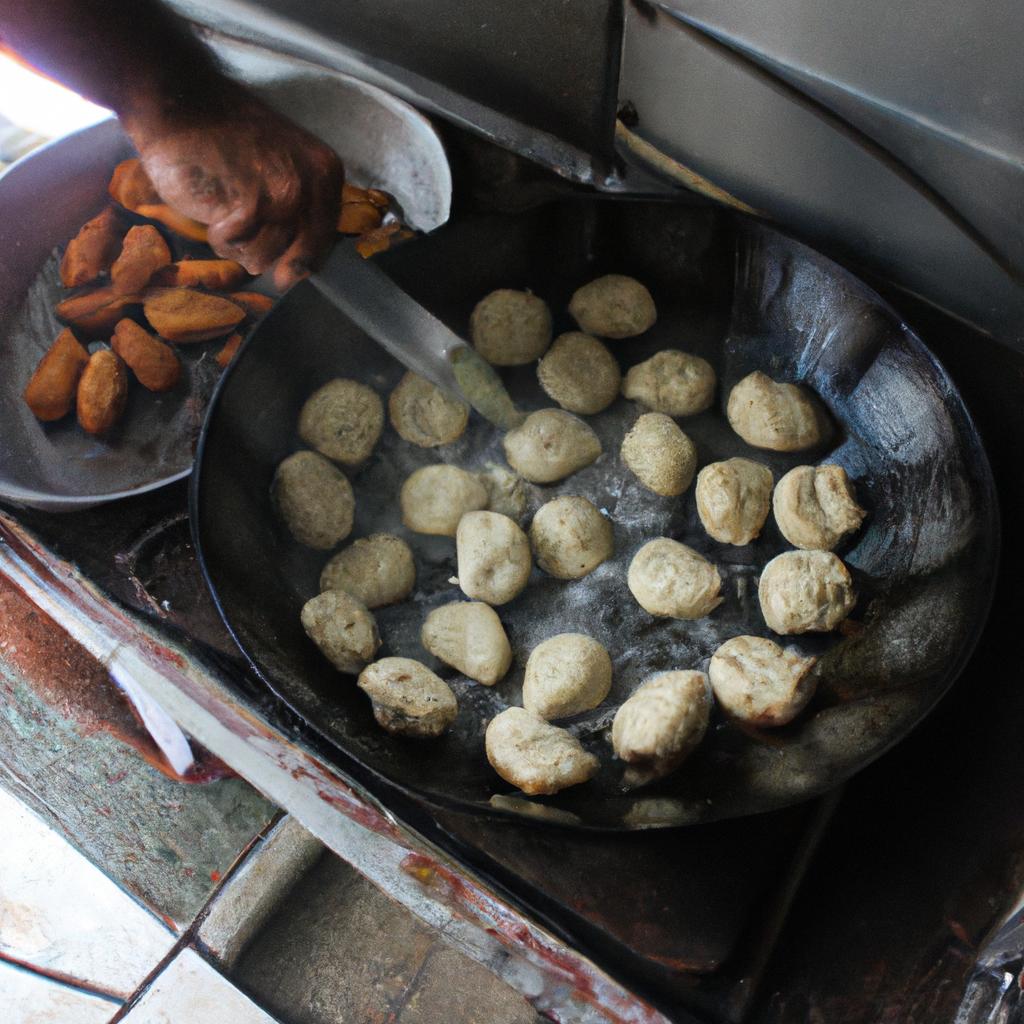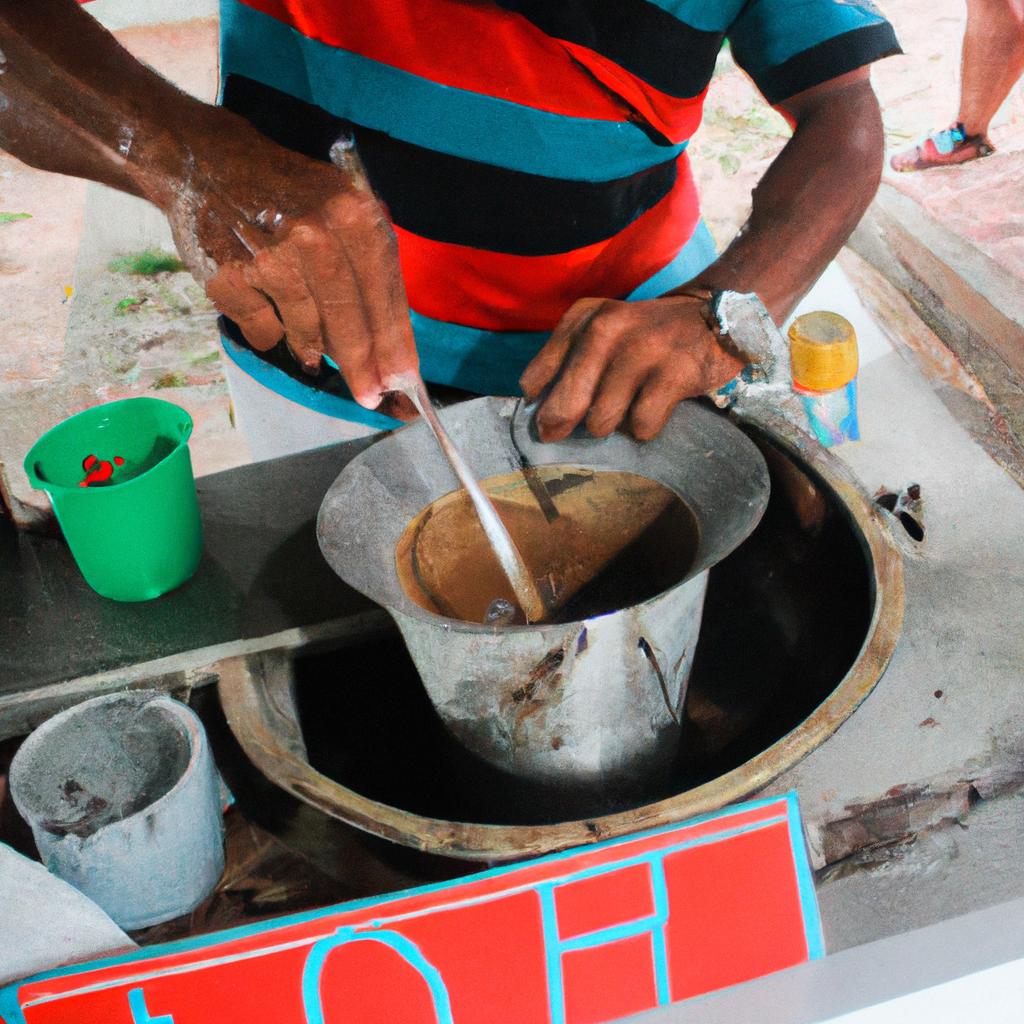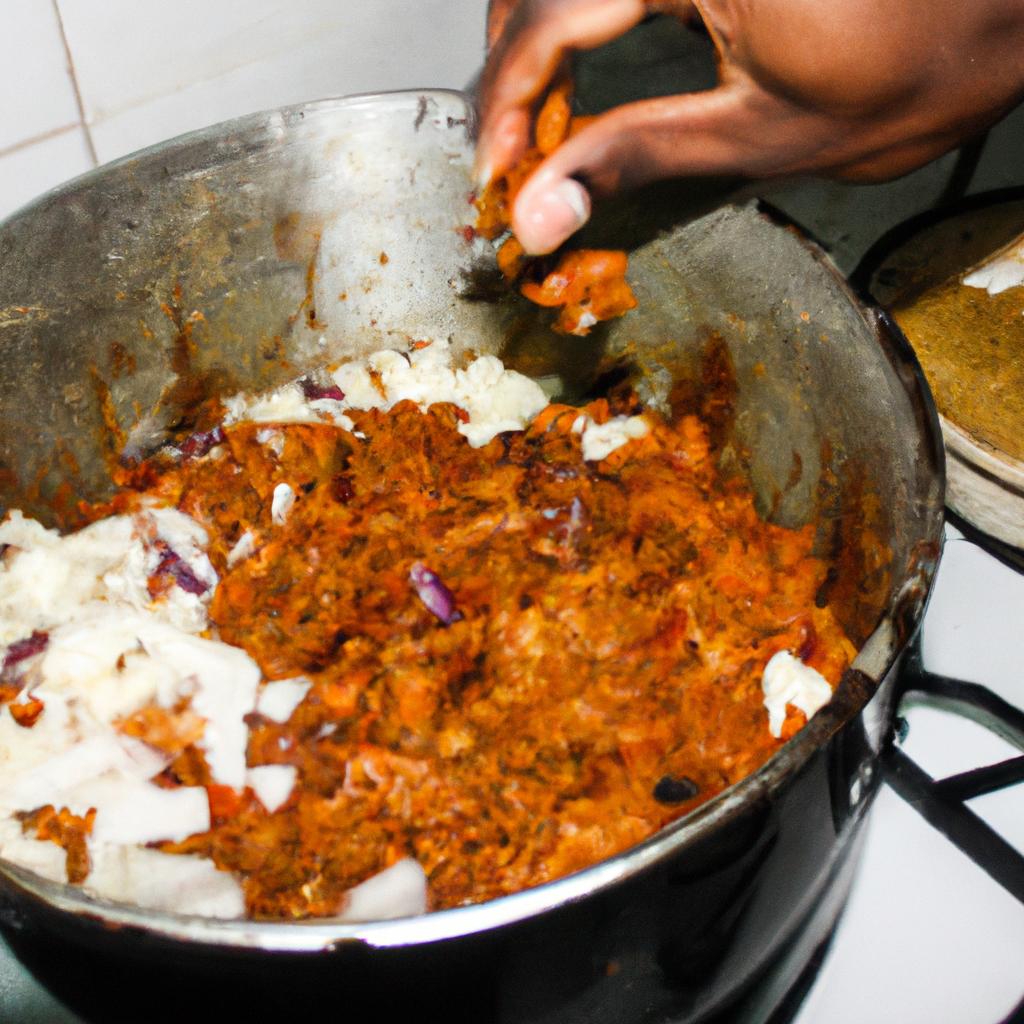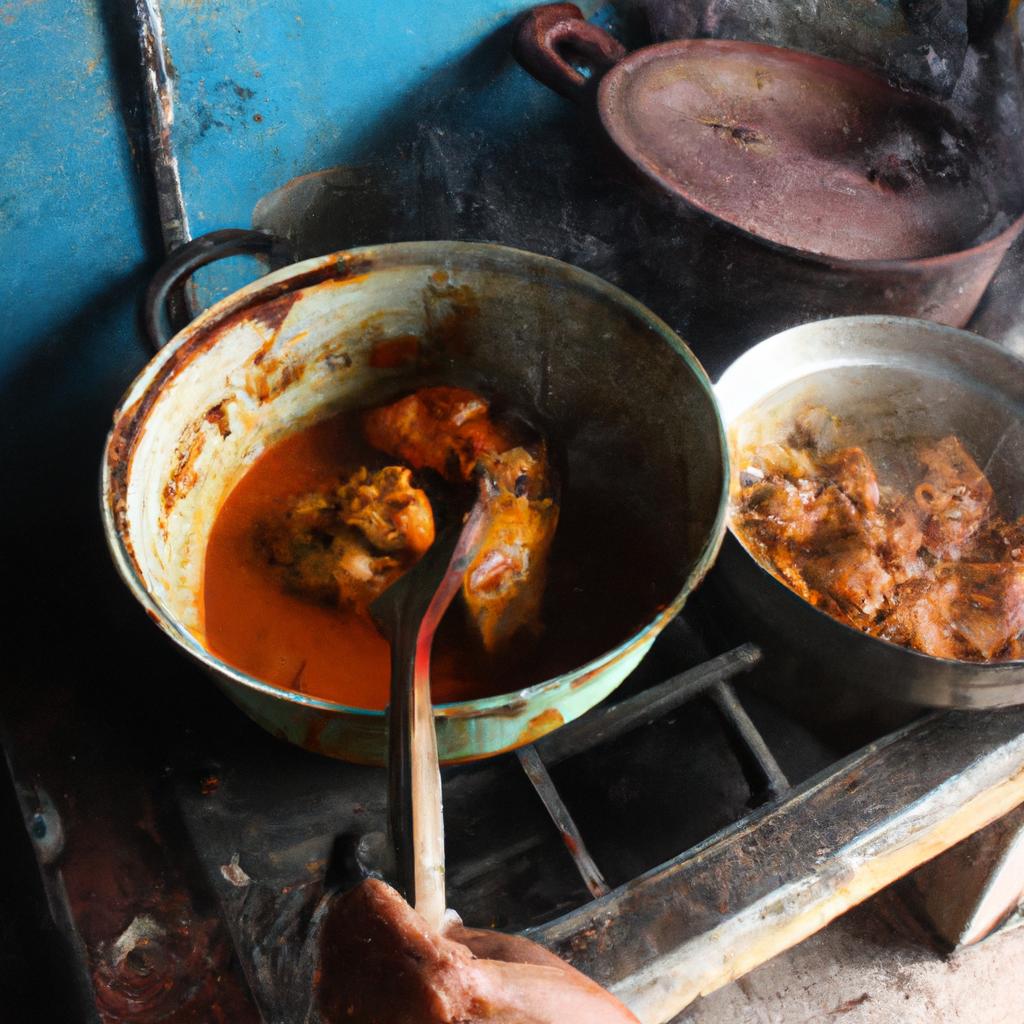Discover the Delight: Puerto Rico’s Local Cuisine through Mofongo
Puerto Rico’s local cuisine is a vibrant and diverse reflection of the island’s rich cultural heritage. Among the myriad of traditional dishes that have captivated both locals and tourists alike, mofongo stands out as an emblematic delicacy. This savory dish showcases the fusion of African, Spanish, and Taino influences that have shaped Puerto Rican gastronomy throughout history. By exploring the origins, preparation techniques, and variations of mofongo, one can truly delve into the essence of Puerto Rico’s culinary delights.
For instance, imagine stepping into a bustling restaurant in Old San Juan where the tantalizing aroma of sizzling garlic wafts through the air. As you take your seat at a wooden table adorned with colorful tropical flowers, you are presented with a plate piled high with golden brown mofongo balls accompanied by succulent chunks of tender pork. The first bite transports you to another world – crispy on the outside yet soft and buttery inside, each mouthful bursts with flavors that dance harmoniously on your palate. In this scenario, mofongo becomes more than just a dish; it becomes an experience that encapsulates Puerto Rico’s unique blend of flavors, history, and culture.
Delving deeper into the realm of mofongo reveals its Delving deeper into the realm of mofongo reveals its fascinating origins and preparation techniques. Mofongo traces its roots back to West African cuisine, specifically the fufu dish made with mashed plantains. The dish was brought to Puerto Rico by enslaved Africans during colonial times and adapted to incorporate local ingredients and flavors.
The traditional preparation of mofongo involves frying green plantains until they are golden and crispy. The fried plantains are then mashed with garlic, salt, and olive oil in a wooden mortar called a pilón. This process requires skill and strength as the plantains must be pounded vigorously to achieve the desired consistency. Once the mixture is thoroughly mashed, it is shaped into balls or molded into a dome shape using a pilón or a mold.
Mofongo can be enjoyed on its own as an appetizer or side dish, but it is often served as an accompaniment to various meats such as pork, chicken, or seafood. One popular variation is “mofongo relleno,” where the mashed plantain mixture is stuffed with ingredients like shrimp, beef, or vegetables before being shaped into balls.
Beyond its traditional form, mofongo has also evolved over time to include creative twists and modern interpretations. Some restaurants offer flavored mofongo options such as bacon-infused or cheese-filled variations. Others experiment with different types of plantains like sweet plantains for a sweeter twist on the dish.
Whether you prefer the classic rendition or enjoy exploring innovative takes on this beloved dish, mofongo undoubtedly holds a special place in Puerto Rican cuisine. Its versatility, rich history, and mouthwatering flavors make it a true culinary gem that continues to captivate food enthusiasts around the world.
History of Mofongo
Imagine yourself sitting in a cozy restaurant in Puerto Rico, eagerly awaiting the arrival of your meal. As you browse through the menu, one dish catches your eye: mofongo. This delectable culinary creation has become synonymous with Puerto Rican cuisine and is beloved by locals and visitors alike.
Mofongo traces its origins back to West Africa, where enslaved Africans brought their rich food traditions to the island during the colonial era. The dish evolved over time as African ingredients were combined with local resources available on the island. Today, it stands as a testament to Puerto Rico’s cultural diversity and culinary excellence.
The history of mofongo is intertwined with the story of Puerto Rico itself. It represents a fusion of African, Spanish, and indigenous Taino influences that have shaped the island’s identity. Much like Puerto Rico’s vibrant culture, mofongo reflects a harmonious blend of flavors and techniques from different culinary traditions.
To truly appreciate the significance of mofongo in Puerto Rican cuisine, consider these compelling facts:
- Symbolic Significance: Mofongo holds deep symbolic meaning for many Puerto Ricans. It embodies their heritage and serves as a reminder of their ancestors’ resilience and creativity.
- Versatility: One of the remarkable aspects of mofongo is its versatility. While traditionally made with green plantains, variations using yuca (cassava) or breadfruit are also popular. This adaptability allows both chefs and home cooks to experiment with different ingredients while staying true to the essence of mofongo.
- Preparation Process: The process of making mofongo involves pounding fried plantains or other base ingredients together with garlic, pork cracklings (chicharrones), olive oil or lard until they form a flavorful mixture. This labor-intensive method showcases dedication and craftsmanship involved in creating this beloved dish.
- Accompaniments: Mofongo is often served as a side dish, accompanied by various proteins such as shrimp, chicken, or beef. It can also be enjoyed on its own with a vibrant sauce drizzled over the top, further enhancing its taste and visual appeal.
These intriguing aspects of mofongo contribute to its popularity among both locals and tourists seeking an authentic Puerto Rican culinary experience. As we delve deeper into the world of mofongo, let us now explore the diverse range of ingredients used in this iconic dish.
Ingredients used in Mofongo
From its humble beginnings as a simple dish, Mofongo has evolved to become an integral part of Puerto Rican cuisine. Its rich history is deeply intertwined with the cultural heritage and culinary traditions of the island. In this section, we will explore the various ingredients that make up this delectable dish, highlighting their significance in creating the unique flavors and textures that define Mofongo.
Imagine yourself sitting at a cozy restaurant in San Juan, Puerto Rico. As you peruse the menu, your eyes are drawn to a dish called “Mofongo con camarones” – Mofongo with shrimp. Intrigued by the sound of it, you decide to give it a try. What arrives on your plate is a masterpiece of flavors and aromas that transport you to the heart of Puerto Rican culture.
To truly appreciate the beauty of Mofongo, let us delve into its key ingredients:
- Plantains: These versatile fruits serve as the foundation for Mofongo. Green plantains are traditionally used, lending a starchy texture and subtle sweetness to the dish.
- Garlic: The pungent aroma and distinct flavor of garlic infuses every bite of Mofongo, adding depth and complexity.
- Pork cracklings (chicharrón): Crispy pork cracklings provide a delightful crunchiness while imparting savory notes that complement other ingredients.
- Olive oil: This essential ingredient not only adds moisture but also enhances the overall taste profile with its smoothness.
Experiencing Mofongo can elicit feelings of:
- Comfort: The warm embrace of familiar flavors evokes memories of home-cooked meals shared with loved ones.
- Excitement: Exploring new tastes and textures awakens curiosity and stimulates our senses.
- Nostalgia: For those connected to Puerto Rican heritage or who have visited the island before, Mofongo can bring back fond memories of past experiences.
- Satisfaction: The satisfaction derived from indulging in a dish that harmoniously combines various flavors and textures cannot be understated.
To further engage our audience, let’s include a table showcasing the different variations of Mofongo:
| Variation | Description | Popular Ingredients |
|---|---|---|
| Mofongo con camarones | Mofongo served with succulent shrimp cooked in garlic butter sauce | Plantains, garlic, pork cracklings |
| Mofongo de churrasco | Mofongo topped with grilled flank steak marinated in tangy adobo seasoning | Plantains, garlic, pork cracklings |
| Vegetarian Mofongo | A vegetarian-friendly version featuring sautéed vegetables such as bell peppers and onions | Plantains, garlic |
| Mofongo relleno | Mofongo stuffed with savory fillings like chicken or seafood, creating a hearty main course. | Plantains, garlic, pork cracklings |
As we conclude this section on the ingredients used in Mofongo, it becomes evident that they play an integral role in shaping the overall taste experience. Each component contributes its unique characteristics to create a symphony of flavors that delight the palate. In the subsequent section about “Traditional preparation of Mofongo,” we will explore how these ingredients come together through time-honored techniques to craft this iconic Puerto Rican dish.
Traditional preparation of Mofongo
Discover the Delight: Puerto Rico’s Local Cuisine through Mofongo
Ingredients used in Mofongo:
In exploring the traditional preparation of Mofongo, it is essential to first delve into the various ingredients that contribute to this delectable dish. One example of an ingredient commonly used in Mofongo is plantains – a staple crop grown abundantly throughout Puerto Rico. These green-skinned fruits are carefully selected and mashed together with other flavorful components such as garlic, pork cracklings (known as chicharrones), and olive oil.
To understand the significance of these ingredients, let us examine their individual contributions:
-
Plantains: The hearty and starchy nature of plantains provides the foundation for Mofongo. When ripe, they offer a subtle sweetness; when green, they lend a more savory essence to the final dish.
-
Garlic: Aromatic and pungent, garlic infuses every bite of Mofongo with its distinct flavor profile. Its inclusion adds depth and complexity to the overall taste experience.
-
Chicharrones: These crispy pieces of fried pork fat enhance both texture and taste, providing a delightful crunchiness that contrasts with the smoothness of mashed plantains.
-
Olive Oil: Serving as the binding agent for all the ingredients, olive oil not only enhances cohesion but also imparts a rich savoriness to each spoonful.
Table: Emotions evoked by enjoying Mofongo
| Emotion | Description |
|---|---|
| Satisfaction | The feeling derived from indulging in a well-prepared plate of mouthwatering flavors |
| Nostalgia | Reminiscing over cherished memories associated with home-cooked meals |
| Excitement | Anticipation building up before tasting something new and unique |
| Comfort | A sense of familiarity and warmth experienced while savoring comfort food |
Moving forward, it is important to note that the ingredients mentioned above are not exhaustive but rather represent the core components of Mofongo. By understanding their significance and interplay, one can gain a deeper appreciation for this traditional Puerto Rican dish.
Transitioning into the subsequent section about “Popular variations of Mofongo,” we will now explore how these basic ingredients can be creatively adapted to suit different preferences and regional influences.
Popular variations of Mofongo
Exploring the Flavors: Traditional Preparation of Mofongo
Imagine yourself sitting at a bustling restaurant in Puerto Rico, eagerly anticipating your first taste of mofongo. The aroma of fried plantains fills the air as you witness skilled chefs expertly preparing this beloved dish. Traditional preparation methods are deeply rooted in Puerto Rican culinary history and have been passed down through generations.
To truly appreciate the artistry behind mofongo, it is essential to understand its traditional preparation process. First, green plantains are peeled and cut into chunks before being deep-fried until golden brown. These crispy plantain pieces are then mashed with garlic, olive oil, and pork cracklings using a wooden mortar and pestle called a pilón. This labor-intensive technique ensures that every ingredient is perfectly combined, resulting in a harmonious blend of flavors.
The traditional preparation of mofongo embodies the essence of Puerto Rican cuisine. It showcases the island’s reliance on locally sourced ingredients and reflects its rich cultural heritage. To further illustrate this point, let us explore some key aspects:
- Connection to Nature: The use of fresh green plantains highlights Puerto Rico’s abundant agricultural resources.
- Preservation of Tradition: The manual process of mashing the ingredients by hand preserves centuries-old cooking techniques.
- Celebration of Diversity: Mofongo represents the fusion of African, Spanish, and indigenous Taino influences that have shaped Puerto Rican culture.
- Sense of Community: Sharing a plate of mofongo brings people together, fostering bonds among family and friends.
This table offers an overview comparing various elements related to traditional mofongo preparation:
| Elements | Description |
|---|---|
| Ingredients | Green Plantains, Garlic, Olive Oil, Pork Cracklings |
| Cooking Method | Deep-Frying |
| Utensils | Wooden Mortar and Pestle (Pilón) |
| Cultural Significance | Reflects Puerto Rican heritage and culinary traditions |
As we delve deeper into the cultural significance of mofongo in Puerto Rico, it becomes evident how this dish has become an integral part of daily life. From family gatherings to festive occasions, mofongo is cherished across the island for its ability to bring people together through shared meals. Join us as we explore the role of mofongo in Puerto Rican culture and uncover the stories behind this delectable creation.
[Transition sentence into subsequent section: Mofongo in Puerto Rican culture] As we continue our journey through the world of mofongo, let’s now immerse ourselves in its profound connection to Puerto Rican culture.
Mofongo in Puerto Rican culture
Exploring the Diverse Flavors of Mofongo
Imagine yourself sitting in a cozy restaurant in Puerto Rico, surrounded by vibrant colors and tantalizing aromas. The waiter brings you a plate of beautifully presented mofongo, one of the island’s most beloved dishes. As you take your first bite, you are instantly transported to a world of flavors that reflect the rich culinary heritage of Puerto Rico.
Mofongo is not just a single dish; it encompasses various regional variations that add their own unique touch to this traditional staple. From the coastal towns to the mountainous regions, each area has its own way of preparing and serving mofongo. Let’s delve into some popular variations that showcase the diversity within Puerto Rican cuisine:
-
Chicharrón de Pollo: In this variation, crispy fried chicken chunks are mixed with mashed plantains and seasoned with garlic and other spices. The combination of tender meat and savory flavors adds an irresistible twist to the classic mofongo recipe.
-
Mariscos al Ajillo: This seafood-infused version takes mofongo to new heights by incorporating succulent shrimp or marinated octopus cooked in ajillo sauce—a flavorful blend of garlic, olive oil, and herbs. The delicate brininess of the seafood complements the robustness of mofongo perfectly.
-
Vegetarian Delight: For those seeking a vegetarian option, there is no shortage of creativity when it comes to plant-based mofongos. One enticing example includes sautéed mushrooms, onions, bell peppers, and fresh herbs folded into creamy mashed plantains—the perfect balance between earthy goodness and indulgence.
-
Sweet Temptation: While traditionally savory, sweet adaptations have also gained popularity over time. Imagine savoring a dessert-like mofongo topped with caramelized bananas drizzled with chocolate syrup—an explosion of textures and flavors that showcases the versatility of this beloved dish.
In order to fully grasp the breadth of mofongo’s significance in Puerto Rican culture, it is worth exploring its role beyond just a delectable meal. Here are some key aspects:
| Key Aspect | Description |
|---|---|
| 1. Historical Roots | Mofongo traces its origins back to West African cuisine brought over by the enslaved Africans who worked on sugar plantations during colonial times. It has since evolved into a symbol of cultural resilience and pride. |
| 2. Festive Celebrations | Mofongo plays an integral part in traditional celebrations such as weddings, birthdays, and religious festivals. Its presence at these events signifies abundance and unity within the community. |
| 3. Culinary Heritage | The art of making mofongo has been passed down through generations, with many families having their own secret recipes and techniques—a testament to the importance placed on preserving culinary traditions. |
| 4. National Identity | Mofongo holds a special place in the hearts of Puerto Ricans as it represents not only their local cuisine but also serves as a reminder of their shared heritage and distinct identity amidst an ever-changing world. |
As you can see, mofongo goes far beyond being just another mouthwatering dish—it embodies history, tradition, celebration, and national pride all rolled into one captivating experience for both locals and visitors alike.
Transitioning seamlessly into our next section about “Where to try Mofongo in Puerto Rico,” let us embark on a journey to explore the best places on the island where you can indulge in this iconic delicacy without stepping too far from your comfort zone or breaking your bank account!
Where to try Mofongo in Puerto Rico
As we delve further into the realm of Puerto Rican cuisine, our exploration takes us to the heart and soul of local flavors – mofongo. One cannot truly appreciate the richness and diversity of Puerto Rico’s gastronomy without experiencing this iconic dish firsthand. With its roots deeply embedded in the island’s culture, mofongo serves as a testament to Puerto Rico’s culinary heritage.
To better understand the significance of mofongo, let us consider an example that showcases its cultural importance. Imagine yourself amidst the vibrant streets of Old San Juan, surrounded by colorful colonial buildings and boisterous laughter echoing through every corner. As you step into one of the renowned local restaurants, your senses are immediately awakened by the enticing aroma wafting from a nearby table. There, before your eyes, rests a plate adorned with golden-brown balls of mashed plantains enveloped in garlic-infused broth – mofongo at its finest.
Why is mofongo so cherished among locals and visitors alike? Here are some reasons why this traditional Puerto Rican delicacy holds such charm:
- Versatility: Mofongo can be enjoyed with various fillings, ranging from succulent shrimp or tender pork to flavorful vegetables or even seafood stew. This versatility allows for endless combinations and caters to diverse palates.
- Nostalgia: For many Puerto Ricans, indulging in mofongo evokes nostalgic memories tied to family gatherings and special occasions. It embodies tradition, bringing people together around a shared love for authentic flavors.
- Cultural identity: Mofongo represents an amalgamation of Taino Indian, African, and Spanish influences that have shaped Puerto Rico throughout history. Its consumption symbolizes pride in cultural heritage while offering a glimpse into generations past.
- Craftsmanship: The preparation of mofongo requires skillful hands that meticulously mash ripe plantains with a mortar and pestle, ensuring the perfect balance of textures. This culinary craftsmanship elevates mofongo beyond mere sustenance and transforms it into an art form.
To further emphasize the allure of mofongo, let us explore its essence through this table:
| Mofongo’s Essence |
|---|
| Sensory Delight |
| Cultural Pride |
| Culinary Craftsmanship |
In conclusion, mofongo stands as a testament to Puerto Rico’s rich cultural tapestry and vibrant gastronomy. By indulging in this beloved dish, one embarks on a culinary journey that transcends taste buds and delves deep into the heart of Puerto Rican identity. Whether you find yourself strolling along cobblestone streets or nestled comfortably within your own home, allow mofongo to transport you to a realm where tradition meets innovation – all in one delectable bite.




